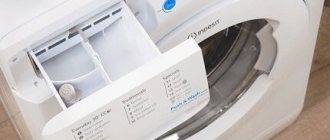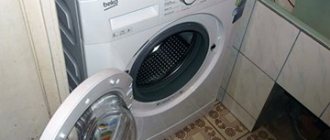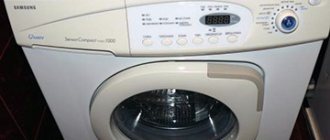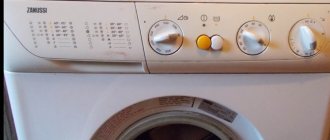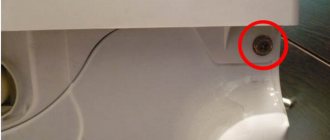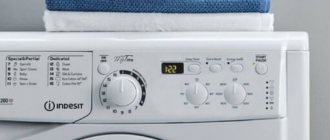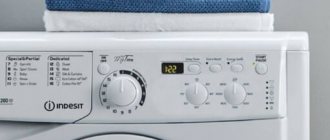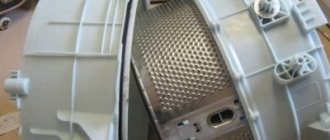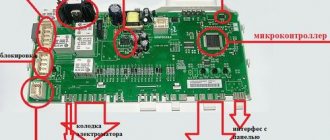Our comfort is largely ensured by household appliances. Few people can imagine their life without her. A striking example is automatic washing machines. Recently it was a luxury item, today it is almost a mandatory requirement for a normal life. But technology is only meant to break down from time to time. Naturally, the less often malfunctions occur, the better, but what to do if the washing machine breaks down? Call a specialist? If the warranty period is valid, this is what you need to do. If the warranty has long expired, you can repair the washing machine yourself. It may not be possible to fix all the faults on your own, but most of them will definitely be able to be fixed.
You don't always have to call a professional
How does a washing machine work?
Repairing a washing machine with your own hands is only possible when you know what it consists of and what role each part plays. When the operating principle and purpose of each part is clear to you, you can determine from the malfunction what the cause may be. So, let’s look at what an automatic washing machine consists of.
The most common models of these household appliances are front-loading - in our conditions, washing machines are located mainly in the kitchen, covered with countertops or in the bathroom. In this case, the front loading hatch is more convenient.
Washing machine device
Control
The control unit consists of a panel and a board. On the panel there are knobs or buttons with which we set the washing modes. The board is responsible for recognizing the specified modes. During the washing process, it controls all parts in accordance with a given program - turns on/off the water supply, controls its heating, the operation of the drum, pump for pumping, etc.
All machine operating parameters are monitored by various sensors. The information coming from them is processed in a microprocessor installed on the board. The control system is actually quite complex, but it is the main part of the washing machine. There are the following sensors:
- Water level sensor. Monitors how much water is in the tank. According to its readings, the water supply is turned on/off.
- Temperature sensors. Located at the bottom of the tank. According to their readings, water heating is turned on/off.
- Tacho sensor. Controls the rotation speed of the drum.
- Time relay. Tracks the time intervals required for various stages.
All these parts are connected to the control board by wires; some circuits contain relays.
The washing machine control unit consists of a panel and a board
If the board is damaged, the machine begins to confuse the programs. This is the main sign that the control board in the washing machine is damaged. All other failures can be associated with incorrect operation of the sensors, but failures in programs are a processor disease. The board is repaired very rarely; usually it is simply replaced. The bad news is that the cost of the board is high, although the replacement itself is not difficult. The connector for connecting it is standard. The old one is switched off. To do this, the conductors are removed from the blocks, and the faulty board is dismantled. A working one is installed in its place, all conductors are connected in place.
The main reason for the failure of the control board is power surges, so it makes sense to power the washing machine through a stabilizer (or install it for the entire apartment or house).
Execution devices
The control board is connected to all the operating devices - drum, electric motor, pump, water shut-off valve, etc. It is their work that is controlled by sensors.
- Hatch door lock. It locks the door and a click is heard when activated. If the door is not pressed tightly, the lock relay will not operate. In this case, the machine will not start washing. In the event of such a breakdown, repairing the washing machine is simple: push the door, the contacts close, and the washing begins.
How to replace the door lock on a washing machine - Water supply valve. The washing machine is connected to the water supply simply with a hose. There is this valve inside at the inlet that turns on/off the water supply. If the machine does not draw water (but there is water in the system and the pressure is normal) or vice versa, water is supplied all the time, the valve is most likely “flying”. In this case, repairing the washing machine yourself consists of replacing the water supply valve. In principle, first you can clean it of salts and contaminants; if this does not help, you will have to change it.
- Engine. Drives the drum. The rotation is transmitted to the pulley through a belt, but there are direct drive washers. If you have a drum with a pulley, it rotates manually, the motor turns on, but when starting, the drum does not rotate, the belt may be torn or loose. In this case, repairing the washing machine yourself consists of replacing the belt. If this problem occurs in a direct drive washing machine, the motor is most likely burned out.
Different types of drives in washing machines - Tubular heating element - heating element. Necessary for heating water. If during washing the water does not heat up, but it should, you need to check the serviceability of the heating element; if everything is in order with it, check the temperature sensors. Due to their incorrect operation, the water may also not heat up.
- Water pump. This is a small pump for pumping water out of a tank. He pumps it out, feeding it into the drain hose.
These are all the main working parts. The failure of each of them leads to a malfunction of the washing machine. Repair mainly consists of replacing a failed element. Only the pump and water supply valve can become clogged. There may also be a blockage in the door lock, it is not accidental - someone could push something there, mostly, of course, children.
Washing machine tank
In a washing machine, the tank takes up almost all the space in the body, since it contains a drum for loading laundry. The drum is movably connected so that it can rotate around a horizontal axis. The heating element and some sensors (temperature, water level) are also located inside the tank; on the body there are pipes for supplying and draining water.
What does a washing machine tank consist of?
To keep the tank in one position while the washing machine is operating, there is a stabilization system. These are springs and shock absorbers that dampen most of the vibrations.
Shock absorbers and/or springs hold the tank and drum in place
The tank itself is usually made of plastic. There are collapsible models, and there are non-dismountable ones. Washing machines with collapsible tanks are usually more expensive, but in this case it’s worth paying extra, since their repair is much easier. If something happens to the bearings, they can be easily replaced by disassembling the tank. Another malfunction of the washing machine in which a collapsible tank is better is a crack in the body. If the shock absorbers do not do their job well, the drum with laundry begins to knock on the tank during the spin cycle. Plastic is not designed for such loads, so sooner or later cracks will appear. If the tank is collapsible, you can replace the damaged part. It's not very difficult or expensive. If it is not dismountable, in theory, you need to replace it along with the drum, which is not cheap at all. But even in this case, you can help the trouble - repairing the washing machine tank with your own hands in this case consists of sealing the crack. It is better to use waterproof and heat-resistant universal glue, which can also be used to glue plastic.
Housing and other parts
Repairing a washing machine yourself begins with disassembling the case. The body is usually made of thin sheet metal coated with a layer of enamel. The top cover is plastic, the back is made of galvanized steel, everything is secured with screws. Where exactly the fasteners are located depends on the company and model. But there are some more elements inside the case.
- Powder supply unit. This is a drawer with several compartments, each of which contains its own product. What to pour where is written in the instruction manual. For repairs, it is worth knowing that the drain hole in this block may become clogged. This happens very rarely, but it does happen. Then the block is removed (pull it out all the way, then lift it up a little), the coked salts and powder residues are removed, after which the block is installed in place.
The powder supply unit is usually located in the upper part of the housing on the left - Counterweights. To prevent the tank from shaking too much during spinning, it is loaded with specially shaped concrete slabs - counterweights. They are attached to the tank at the top and bottom.
Counterweights in a washing machine are large concrete slabs that stabilize the position of the drum.
These are all the main components of a horizontal loading washing machine. Next, we will consider their interaction during operation.
Doesn't pick up water or it picks up slowly
If the washing machine does not draw water or does it very poorly, there may be several reasons for this:
- supply valve is closed;
- the inlet hose is clogged or deformed; you need to straighten it and clear the blockage;
- the intake filter is coked; to clean it, turn off the water, disconnect the hose from the machine, remove the filter and rinse it under a strong stream of water, and then perform all the steps in the reverse order;
- the intake valve is clogged and out of order; you need to turn off the water and replace it;
- the water level regulator has failed; when the water level in the drum rises, the displaced air puts pressure on the pressure regulator and the switch is triggered; If the system is clogged or damaged, water will not be drawn.
Another reason why water is drawn into the machine very slowly or does not flow at all may be due to low pressure in the system. This is not a breakdown and you cannot fix it yourself. As soon as the pressure in the system returns to normal, everything will correct itself. If this situation repeats regularly, then to eliminate it you need to increase the pressure in the system. For example, install a pressure tank in the attic of a private house or under the ceiling of an apartment.
How does an automatic washing machine work?
To repair it yourself, you also need to know how the washing machine works. This will help determine the element that could lead to this breakdown. So, here is the operating procedure of the washing machine:
- When starting the car, the condition of the door lock is tested. If the door is closed, the lock is blocked, after which the water supply is turned on (the valve opens). Water flows through the powder supply unit.
- Water is drawn in until its level reaches the sensor, after which the valve closes.
- Next, if the mode is set to no soaking, the heating element turns on.
- The engine runs simultaneously with the heating element. The rotation speed is low, the direction is variable - sometimes in one direction, sometimes in the other.
Main nodes - After a certain period of time (depending on the running program), the dirty water is pumped out.
- A new portion is poured. Upon reaching the specified level, the drum begins to rotate in different directions - the laundry is rinsed.
- After a few minutes of operation in this mode, the engine turns off and the pump turns on, pumping out the water.
- The last stage is spinning. The engine rotates the drum at high speed, while the pump operates at the same time, pumping out the squeezed water.
There may be deviations in this algorithm - some programs have additional steps. For example, soaking and double spinning. But there are no innovations in them. Soaking occurs in the same way as rinsing, with double rinsing there are no problems at all, just water is pumped in twice.
Knowing this algorithm will help you determine where and at what stage the failure occurred. Accordingly, it will be possible to determine which parts of the machine may have broken.
It just stops in the middle of the washing process
If the washing machine stops during washing and does not complete it, there may be several reasons:
- There is a blockage in the system. Forcefully drain the water and clean the inlet and outlet hoses and all possible filters.
- The electricity supply has stopped. Check the plugs and machines on the panel, smell the socket, check if there is light in another part of the house, call all contacts.
- Incorrect mode selection. Perhaps there is a pause in the program you have chosen and you just need to wait.
- The pump is broken, water is not pumped out at the right time and the washing process is disrupted.
- The water pressure in the system has dropped. Check the pressure of water flowing from any tap in your home. If the pressure is weak, pause the wash, wait until good flow returns and continue.
- The thermostat or heating element is broken, the water does not heat up to the required temperature, and the program crashes.
- The outlet hose is leaking and water is constantly going down the drain. At the same time, the system pumps water into the drum to the required level, the processor always “thinks” that the water has not yet filled. To eliminate the problem, you need to check the reliability of the connection between the outlet hose and the drain riser.
- The control timer has burned out. The machine “does not understand” when to end one process and start another and therefore stops completely. This is a rather complex device. You won't be able to repair it yourself; it's easier to buy and install a new one.
- The electric motor burned out. This breakdown is also very difficult to repair on your own; you will have to call a specialist.
Do-it-yourself washing machine repair: the most common breakdowns
Although the designs of the machines are very similar, there are differences in them. However, there is a certain set of faults that are common to all washing machines.
Wash does not turn on
Repairing a washing machine with your own hands begins with the fact that you need to determine at what stage the program stopped. Sometimes the washing machine fails to start. There are several possible reasons:
- The door is not closed. Until the relay operates, the wash will not start. Push the door firmly against the body. If this does not help, there may be a foreign object in the lock or the latch may be faulty.
- No power or voltage too low.
- Check the integrity of the plug, socket, and cord.
The cord may fray - The contacts on the terminal block where the power cord is connected may be oxidized. In this case, remove the cover of the washing machine, find the block and inspect the contacts, clean them if necessary.
- The time relay is faulty. Diagnosing its failure is not easy. You just need to switch programs several times. If at some point the washing starts, then the time relay is really faulty.
If all these points are checked, there are no faults, but the washing machine still does not turn on, the problem may be in the control board. This can only be determined by installing the working board.
Water does not fill
If the machine does not fill with water, first check if there is water in the water supply. It is also worth checking its pressure (open the tap and evaluate the pressure). If it is sufficient, we move on:
- Check the water supply hose. It may be pinched.
- The water supply filter is clogged. Then we act like this: shut off the water supply to the machine;
- remove the supply hose from the pipe;
- Using pliers, remove the filter from the machine and rinse it under running water;
- install it in place, put on the hose.
How to clean the filter on a washing machine
- connect to the inlet hose, in normal condition it is closed, so the water can be opened;
This is the intake valve
The same reasons lead to another breakdown - water is drawn into the machine slowly. If the pressure is normal, then either the hoses are pinched/flattened/clogged or the filter is clogged.
Water does not heat up
If the water in the machine does not heat up, the first thing that comes to mind is that the heating element has burned out. In this case, repairing the washing machine yourself consists of replacing the heating element. But this is not the only reason. There are three of them:
- The water level sensor is faulty. The heating element turns on only when there is enough water in the tank. If the sensor incorrectly detects the water level, the command to turn on the heating element is not given. Such a malfunction can be treated by replacing the sensor. It happens like this:
- Remove the top cover of the machine.
- We find the water level sensor (pressostat). This is a small plastic box on one of the side walls of the case. Conductors and a thin tube are connected to it.
- We unscrew the two bolts that secure the relay, remove the tube (unclench the clamp). If the tube is hard at the end, cut off the hard part (no more than 12-15 mm).
- Find a tube of the same cross-section as you just disconnected (about 10 mm) and a length of 20 centimeters or more. Place one end of the tube on the fitting and blow on the other. Keep the pressure switch near your ear. If you blow and hear a click, then the relay is working. If, despite all efforts, there is no click, the relay is faulty. You can measure the conductivity of the winding while blowing into the tube. In operating condition, the conductivity changes.
- We install the working pressure switch in place.
This is a water level sensor (pressostat). The body color can be any - The heating element is working, but the contacts have oxidized. In this case, having reached the contacts, they are cleaned to bare metal.
- Thermal relay is faulty. These sensors are located under the loading hatch. They can be of different shapes, as well as different types: bimetallic or gas-filled thermostat (looks like a tablet with a diameter of 2-3 cm) and a thermistor (in new models). Having removed the temperature sensor from the tank housing of the washing machine, we check it:
- We measure its resistance in a cold state.
- Apply it to a pan of hot water, wait a few minutes, and measure the resistance again.
- The difference must be very big. If so, then the relay is working normally. If the resistance has changed slightly, you need to replace the part with a similar, but serviceable one.
The thermal relay is responsible for timely turning on/off the heater.
If the water in the washing machine heats up, but for a very long time, most likely scale has formed on the heating element. You will have to extract the heating element and clean off the scale from it.
The drum does not spin
There are again several reasons. The first, most terrible thing - the engine burned out. To do this, you need to check the presence of voltage at its terminals. If there is no voltage, the motor is faulty. Other problems are not so global:
- The drive belt has slipped or loosened (if the washing machine has a rotary drive). Some models have the ability to adjust the belt tension. To do this, loosen the bolt securing the engine, pull it back a little, and secure it. There is no need to move too much - too much tension will lead to rapid wear of the bearings.
- In case of replacement, you need to put the belt on the pulley like this: pull the belt away from you with your hand and turn the pulley counterclockwise. To remove, we do the opposite.
How to put a belt on a pulley
Another possible option is that something has gotten between the tank and the drum that is blocking rotation. In this case, you need to disassemble the drum and remove the interfering objects.
Water does not drain
There are a lot of options here. There are too many factors, so this time repairing a washing machine with your own hands may take a lot of time - until you go through all the reasons... So, let's start with the simplest:
- The drain hose is pinched.
- If the car has stopped altogether, but the indicators are on normally, check if you accidentally pressed “Stop” and the car is in standby mode.
- The water level sensor is faulty. We have already written about it (the water does not heat up), the test is similar.
- The filter on the outlet pipe is clogged. It is always located on the front of the case at the bottom right, but, depending on the company, it can be hidden behind a small door (Indesit, Bosh, Sanussi) or behind a removable plastic panel (Sumsung). The filter has a small handle by which you need to unscrew it. Just place the container first - all the water in the drum will flow onto the floor. We wash the filter and put it in place.
How to clean the exhaust filter of a washing machine - The pump impeller is blocked. When washing, sometimes small objects get into the tank. They can get between the impeller blades and block it. The impeller is located behind the filter, so first remove the filter. Then, sticking your finger in, we feel for the impeller and check if anything is interfering with it. We remove the blockage. It may happen that the impeller is skewed. Then you will have to change the pump, because it will not work in this form.
Water is leaking from the washing machine
In this case, there are two different situations: it leaks a little and it leaks a lot. The reasons are similar, you can check everything. The first thing to do is drain the remaining water (by unscrewing the outlet filter - see the previous paragraph). If it’s not clear where it’s coming from, but not from the door, we start checking with the simplest thing:
- We check to see if the sewer hose has popped out or if the pipes are clogged.
- We inspect the place where the exhaust hose is attached to the car. It's attached to the pump, so you have to get to it. For washing machines Samsung, LG, Candy, Beko, Ariston, Ardo, Indesit, Whirpool, access to the pump is obtained simply by turning the unit over - the pump is located at the bottom. A drain hose comes from it. It may leak at the connection point, then loosen the clamp, move the hose a little, and tighten it again. Electrolux and Zanussi will have to disassemble the case. You need to remove the cover, then unscrew the back wall (you will have to remove the inlet valve by unscrewing the bolts securing it). There will be a pump and drain hose.
This is what attaching the drain hose to the pump looks like.
Next, you will need to disconnect the pump from the wall so that you can get to the drain hose (remember how the pump is attached, or better yet, take a photo). Further work is similar. - Replacing the drain hose. It happens that the hose is cracked or frayed. Then it needs to be replaced. You already know how to access the connection point of the drain hose, and replacement is a simple matter. We removed the clamp, pulled the hose off the pipe, looked at where and how the hose is attached to the walls of the car (take a photo), and disconnected it. We took a new one, secured it to the walls, pulled it onto the pipe and tightened the clamp.
If it leaks from under a closed door, the reason is the wear of the elastic lining.
The car vibrates a lot
Typically, this breakdown occurs at the spin stage. The car starts knocking and jumping. In this case, repairing the washing machine yourself is rarely necessary. Most often, the reason is that the machine is overloaded or that the laundry is bunched together and not distributed throughout the drum as it should be. It's simple: we stop the washing, take out some of the items (if there is an overload) or distribute them. Turn it on and continue washing.
If none of these reasons are confirmed and the knocking becomes constant, the suspension springs may have broken, the shock absorbers have failed, or the ballast has become loose. The treatment method is clear: replacing the suspension springs or shock absorbers, tightening the bolts on the ballast.
The machine fills with water, but the washing process does not start
There may also be several reasons:
- The heating element burned out. If this happens, the sequence of processes is disrupted and washing does not start. The unit needs to be replaced.
- The belt drive is broken. You'll have to completely disassemble the machine to see this.
- The water level or temperature sensors have failed.
- The processor has burned out. The washing machine does not receive any commands and does not understand what it needs to do.
- The inlet valve is faulty. It may not open well or close tightly as a result of clogging. It is necessary to eliminate the blockage, and to prevent the situation from repeating again, install an additional filter at the inlet.
- The most unpleasant and expensive reason to repair is a burnt-out electric motor. You definitely won’t be able to fix such a breakdown yourself, of course, if you don’t know how to rewind electric motors.
The water doesn't drain at all
The most harmless reason may be choosing the wrong washing mode. Check to see if the switch is in the delayed rinse mode. It is also likely that the wash program has stopped due to a lack of electricity - check the plugs.
Another quickly removable reason that water does not drain from the washing machine may be a clogged filter or drain pipe, or a bent pipe. Check and clean these components and reconnect the machine.
A clogged or broken pump is another cause of malfunction. Forcefully drain the water, disconnect the pump, clean it or replace it with a new one.
The next reason why the washing machine does not drain water may lie in the electrical part: any contacts have oxidized, the timer or water level switch has failed. All these areas need to be “ringed” and, if necessary, the damaged part must be replaced.
Possibility of self-repair
When repairing a vertical washing machine or repairing horizontal equipment, you need to know its structure and arrangement of components. Improper intervention can aggravate the situation and lead to even greater damage.
For the home craftsman, there is a list of parts that you can replace yourself.
- Drive belt
- Pump
- Thermal sensor
- Filter
- Control board
- Ten
- Pipes and filters
Switches off in spin mode or does not wring out clothes well
Most often, the washing machine does not spin clothes because the drain system is clogged. To correct the situation, you need to clean the filter and remove hair, threads and various small objects that have gotten into the system.
If it doesn’t help, then the pump may have burned out and water is not being pumped out of the tank.
When the water drains normally, but the spin cycle does not work, the drive belt is worn out or stretched. To fix the problem, it needs to be tightened or replaced with a new one.
Preventative cleaning measures
Due to frequent use of equipment, malfunctions occur. Therefore, it is necessary to carry out regular prevention:
- Before washing complex laundry, you must make sure that all items are removed from your pockets and that there are no sharp buttons or protruding decorative elements on the surface.
- Check the condition of the rubber seals regularly. If they are not tensioned tightly, then water seeps through them and the drum begins to rust. Signs of damage can be seen in these same elastic bands: as soon as they darken, they need to be pulled closer to the body.
- Check the condition of the water that is pumped into the tank. If there is excessive salt content in it, the tank becomes coated. Regular cleansing is the ideal solution to the problem.
- You should not load the tank with a large number of things, so as not to wear out the fasteners and other parts.
Advice
Before each load of laundry, it is necessary to check that the drum is securely fastened and that there are no visible changes in its appearance, first pour water into the tank and run it idle to make sure that the engine is working properly.
Water is leaking from the machine
In order to determine exactly where and how much the leak is, you need to perform a simple operation. Wipe the floor dry and place a dry cloth under the machine. Run a short wash cycle without any laundry or powder. Carefully inspect the rag, you will see from which side you need to look for a leak.
The main reasons for a washing machine to leak can be due to: cracks in the hoses, loose clamps, misalignment or rupture of the seal on the door, and so on. If all parts of the machine are intact, the reason may be that the sewer is clogged and the water simply has nowhere to go.
Noise and rattling during operation
Such a malfunction can be determined by the nature of the sound that the machine makes.
If you hear an uneven metallic ringing, knocking or rattling noise that stops when the drum stops, most likely small metal objects have entered the machine. These could be coins, nuts, keys that have fallen out of your pockets. (See also: Why does the washing machine make a lot of noise when spinning) A buzzing sound that becomes quieter when you press hard on the door indicates a broken latch. If you do not fix it in time, the door may jam at the most inopportune moment.
A squealing sound when the drum rotates indicates the drive belt is slipping. Try pulling it, everything should work out.
Crackling and knocking noises during drum operation indicate bearing wear. You will have to replace the bearing in the washing machine. If this is not done, the shaft may break and repairing the machine will cost much more.
The drum does not spin
To find the reason why the drum does not spin in the washing machine, you need to:
- Check the selected mode; perhaps the washing program includes a pause.
- Inspect the drive belt. It probably came off or was stretched. To check the tension level, press the belt. Its displacement should be approximately 12 mm. If your washing machine is equipped with a tensioner, loosen or tighten the belt to the desired level. In cases where such a design is not provided, the only way out of the situation is to replace the belt.
- Pull the loading hatch door. If the latch is broken or jammed and the door does not close tightly, the drum will not work. Open the door and close it sharply again, pressing firmly. If all else fails, the lock is broken and requires replacement.
- Ring the electric motor. It is likely that it burned out.
Cleaning the filter
This is the simplest type of repair and is very easy to carry out. There is a small door at the bottom of the unit that needs to be opened. Then you need to unscrew the rubber plug behind which the filter is located.
The filter itself is washed with clean water; all debris that is collected in the filter must be removed by hand. Then the clean and washed filter is installed in place; this procedure must be performed regularly.
The water doesn't heat up
First of all, you need to disassemble the machine and inspect the heating element. It is likely that too much scale has formed on it or it has burnt out. In the first case, it is enough to clean the heater from limescale; in the second, the unit will have to be replaced. (See also: How to descale a washing machine)
If the automatic machine does not heat the water, then the reason may lie in the water level regulator. When the device is broken, the unit simply “does not understand” that there is enough water and it’s time to turn on the heating element.
Another likely cause could be a broken thermostat. It turns off the heating element even before the water heats up to the required temperature.



